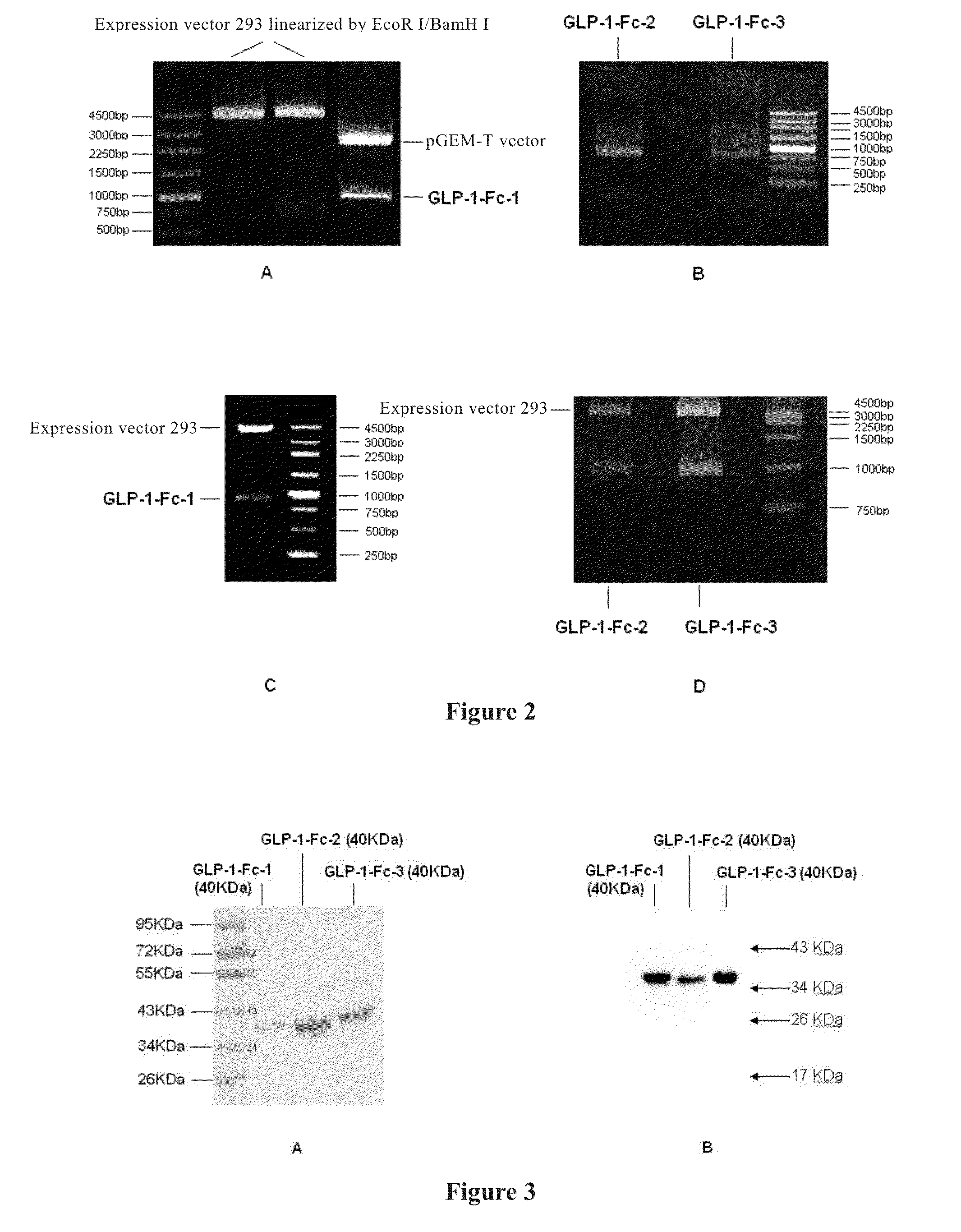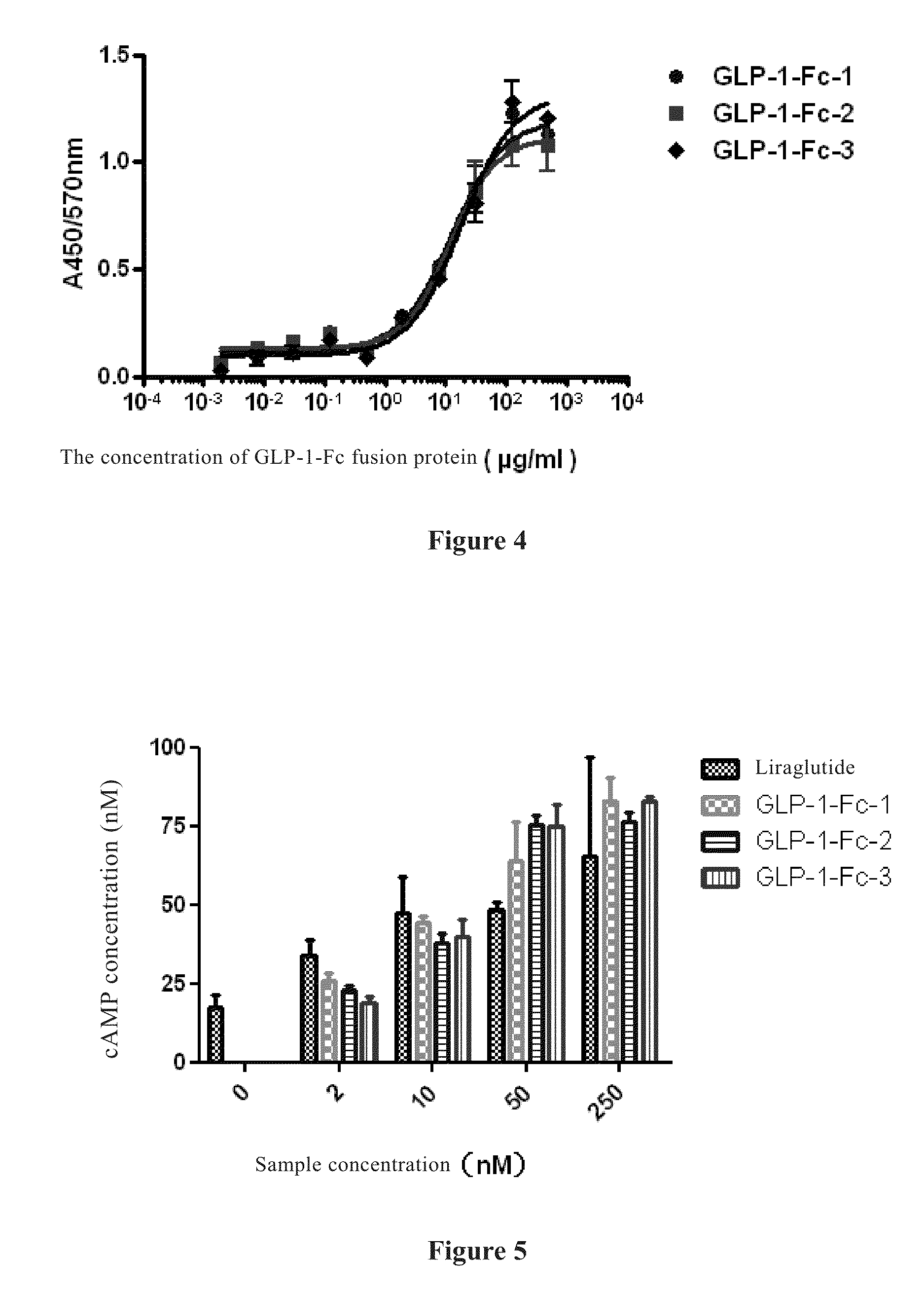Long-Acting Blood Sugar Decreasing Fusion Protein
- Summary
- Abstract
- Description
- Claims
- Application Information
AI Technical Summary
Benefits of technology
Problems solved by technology
Method used
Image
Examples
example 1
Construction of the Expression Vector Encoding the Fusion Protein of the Present Invention
[0069]The gene (SEQ ID NO: 1) encoding the GLP-1-Fc-1 fusion protein of the present invention was synthesized and cloned into pGEM-T plasmid vector by Shanghai Generay Biotech Co., Ltd. The gene contains EcoR I, Not I and Hind III enzyme cutting sites at 5′ end, and TGA termination codon and Pme I, Xho I, and BamH I enzyme cutting sites at 3′ end. The pGEM-T plasmid vector was designated as GLP-1-Fc-1-T.
[0070]The plasmid vector GLP-1-Fc-1-T was double digested with enzymes EcoR I and BamH I (purchased from NEB Co.) (37° C., 4 hours) according to the instruction. 1% agarose gel electrophoresis (FIG. 2A) showed that a gene fragment encoding the GLP-1-Fc-1 fusion protein with a length of about 950 bp, and a pGEM-T plasmid vector fragment with a length of about 3000 bp were generated after double enzymatic digestion. GLP-1-Fc-1 gene fragment was extracted by a gel extraction kit according to the in...
example 2
Expression of the Fusion Protein of the Present Invention
[0077]The expression of the recombinant expression vectors 293-GLP-1-Fc-1, 293-GLP-1-Fc-2 and 293-GLP-1-Fc-3 constructed in Example 1 can be carried out by the method of transiently transfecting FreeStyle 293F cells (R790-07, purchased from Invitrogen Co.). 24 hours prior to transfection, FreeStyle 293F cells were subcultured at a concentration of 6×105 cells / ml, and cultured in a constant temperature shaker at 135 rpm under the condition of 37° C. and 8% CO2, such that the cell density is about 1.2-1.5×106 cells / ml on the day of transfection. The cells were diluted with the FreeStyle 293F culture medium (12338-018, purchased from Invitrogen Co.) to the density of 1×106 cells / ml. To ensure the optimal transfection effect, the cell viability should be more than 95%.
[0078]The transfection agent FreeStyle Max Reagent (16447-500, purchased from Invitrogen Co.) was mixed well by gentle reverse mixing for 4 times. 625 μg of 293-GLP-...
example 3
Purification of the Fusion Protein of the Present Invention
[0080]The supernates of the FreeStyle 293F cells respectively containing the three fusion proteins of the present invention obtained in the above Example 2 were applied to a Protein A column (71-5000-09 AD, purchased from GE Healthcare Bio-Sciences Co.) on an AKTA instrument (purchased from GE Healthcare Bio-Sciences Co.), to capture the three fusion proteins, respectively. The three fusion proteins were eluted with 50 mM citric acid-sodium citrate buffer (pH=3.3) to collect the eluates, respectively (each about 0.5 ml); and 100 μl of 1 M tris(hydroxymethyl)aminomethane-hydrochloric acid (Tris-HCL) buffer (pH=11.0) was added to neutralize the eluates to be neutral. The protein contents were determined at OD280 nm respectively, and then the proteins were dialyzed against phosphate buffer PBS (0.01M Na2HPO4.12H2O+0.002M KH2PO4P+0.14M NaCl+0.002M KCl, PH=7.2) through a 10 K dialysis membrane, filtered and sterilized through a 0...
PUM
| Property | Measurement | Unit |
|---|---|---|
| Capacitance | aaaaa | aaaaa |
Abstract
Description
Claims
Application Information
 Login to View More
Login to View More - R&D
- Intellectual Property
- Life Sciences
- Materials
- Tech Scout
- Unparalleled Data Quality
- Higher Quality Content
- 60% Fewer Hallucinations
Browse by: Latest US Patents, China's latest patents, Technical Efficacy Thesaurus, Application Domain, Technology Topic, Popular Technical Reports.
© 2025 PatSnap. All rights reserved.Legal|Privacy policy|Modern Slavery Act Transparency Statement|Sitemap|About US| Contact US: help@patsnap.com



